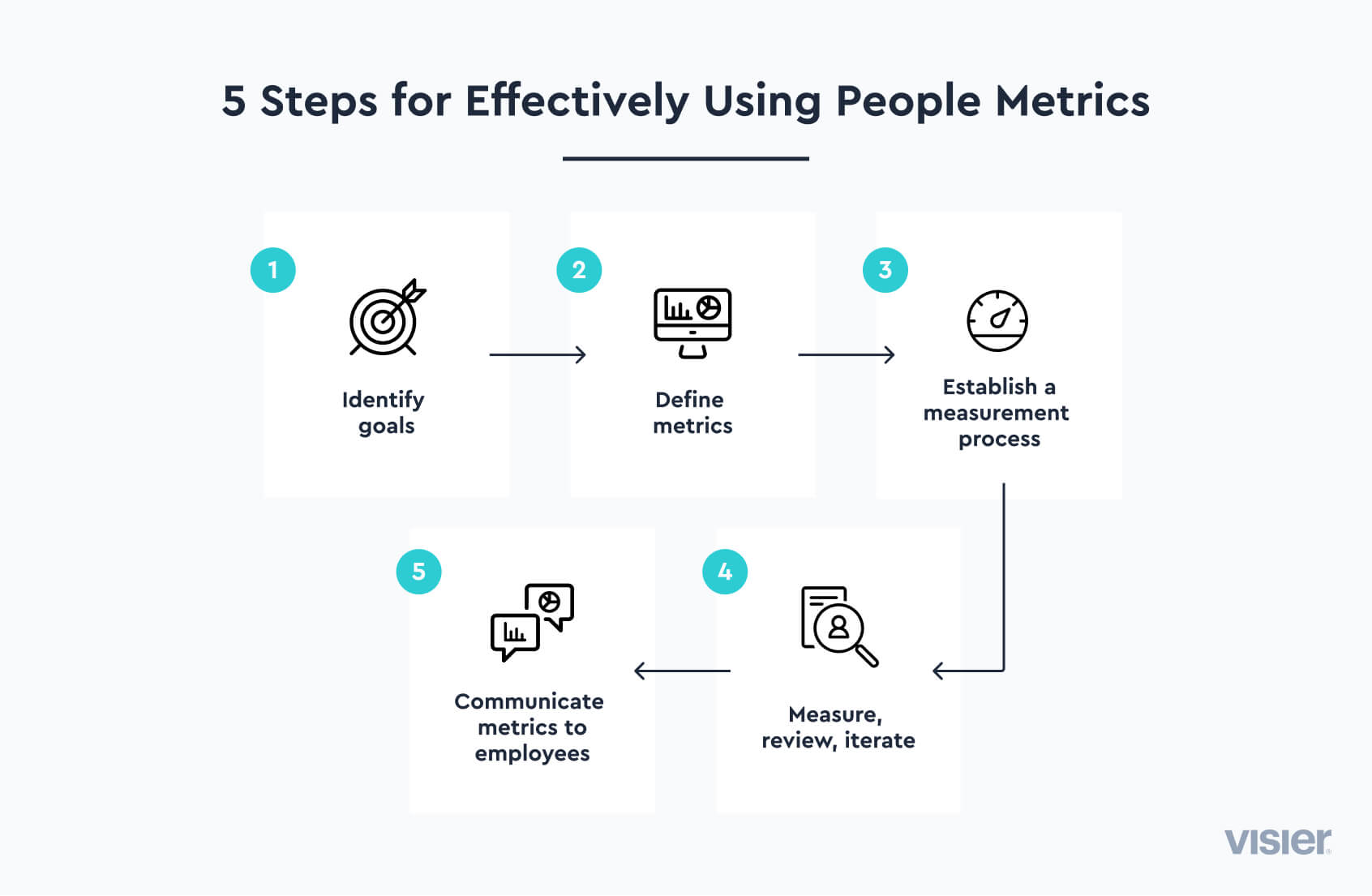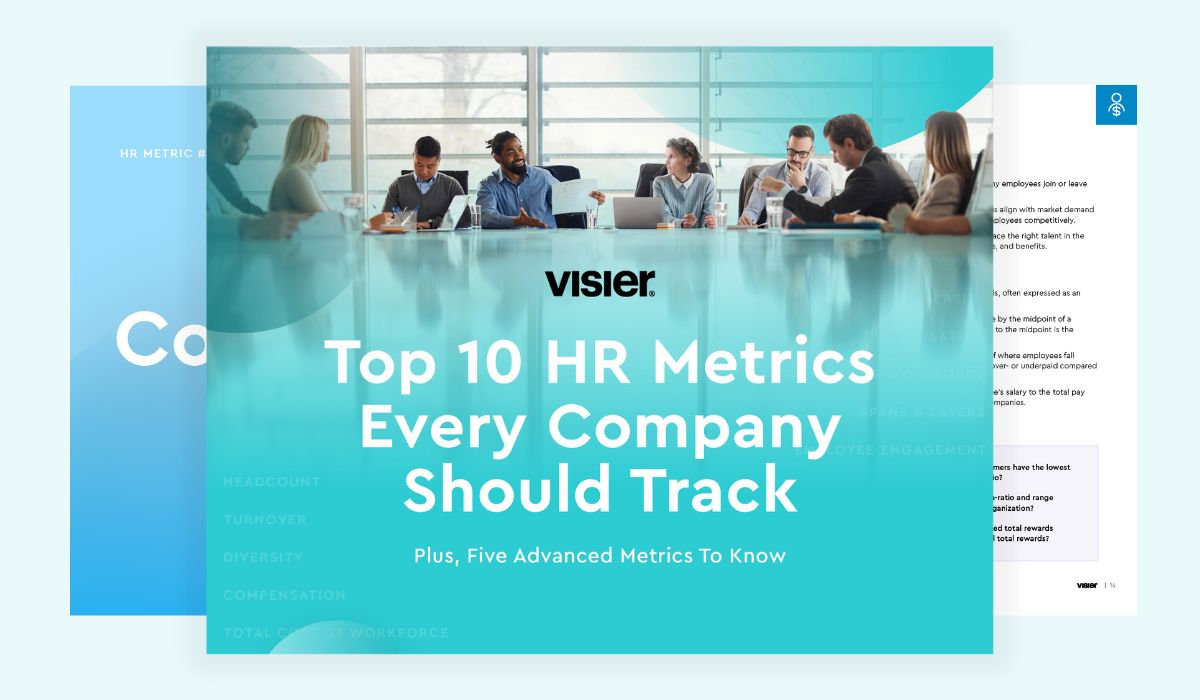HR ANALYTICS
Using People Metrics for Better Business Results
Organization’s need a way to reliably measure their people strategies. People metrics are a key piece of that process. Learn more.
Take a tour
Table of contents
What are people metrics?Pros and cons of people metrics5 steps for effectively using people metricsExamples of people metricsUse the right tools to understand and act on people metricsWhat are people metrics?
People metrics are a way to measure and analyze the effectiveness of your existing people strategies. They include various data points about your workforce such as demographics, compensation, skills, attrition, and more. People, of course, play a key role in the success or failure of modern companies. People metrics are how those companies measure and quantify the impact their employees have.
In business settings, people metrics simply refers to various methods of measuring aspects of an organization’s human capital. As we’ll see in the examples section, these factors can include things like employee satisfaction, turnover rates, and productivity.
Businesses use people metrics to better understand the health and operation of their vital human resources, and they leverage those people metrics to inform policy decisions.
One hundred years ago, a successful business may have been one with state-of-the-art machinery or well-laid-out factories. Today, while physical assets are still quite important in many industries, it’s people that truly drive the success or failure of companies in the modern, information-based economy.
Companies spend huge sums of money and enormous effort recruiting, onboarding, training and developing their human assets. Consequently, they should know how those investments are working out, and it takes people metrics to conduct that analysis.
In this article, we’ll provide an overview of people metrics, including some pros and cons, people-metric process steps and examples of people metrics.

Pros and cons of people metrics
People metrics are widely used in businesses of all types and sizes across the world, so it should be fairly obvious that they offer many advantages. As with any business process, however, people metrics can be misused or can be counterproductive in certain circumstances.
Let’s look first at the pros.
Pros of people metrics
The main pros of people metrics all relate to more objective and transparent decision-making about your workforce and human capital.
Here are some specific pros of people metrics.
Apples-to-apples evaluations
By establishing consistent systems of measurement, people metrics allow businesses and managers to conduct apples-to-apples comparisons between staff and teams.
This means that it’s easier to compare the level of employee engagement on the finance team versus the marketing team, for example, or to more objectively evaluate two candidates for an available promotion.
Recognizing the significance of human capital
Applying objective metrics to people management helps recognize the significance of the people that run an organization. Taking the time to create and track people metrics demonstrates a company’s commitment to its people.
More effective planning
By helping to better understand the current health and capabilities of a company’s workforce, people metrics allow for more effective planning. It’s very hard to determine what opportunities are available to an organization, let alone capitalize on those opportunities, without understanding the nature of the available workforce.
Linking policies with outcomes
After the fact, people metrics are critically important for evaluating the effectiveness of people strategies. How can a company know whether a new employee engagement initiative has been effective if they don’t have a reliable way to track employee engagement before and after the completion of that initiative?
Cons of people metrics
The cons of people metrics, on the other hand, relate to general issues associated with big data and statistical analysis.
Here are some specific cons of people metrics to keep in mind.
Requires some statistical competencies
While people metrics can prove to be very powerful for people management, their effective use requires some level of competency in statistical analysis and data management. These are skills that aren’t necessarily in ample supply in all HR departments.
Data analysis has not, historically, been a required competency for many HR roles. Today, though, these competencies are must-haves for most organizations. Without the ability to competently make sense of large volumes of data, those trying their hands at people metrics may find themselves hopelessly lost or, even worse, making misinformed decisions.
Requires consistent metrics
To provide valid and reliable results, it’s critical that consistent metrics be used across the organization.
While a certain level of subjectivity is part of the human resource process—performance evaluation, for instance—the more consistent metrics are, the better the insights they can provide.
For example, if the operations department is using completely different metrics, or definitions, then the finance and marketing departments, valid comparisons will not be able to be made across these departments.
Having inconsistent metrics makes it virtually impossible to make meaningful use of people metrics at an organizational level.
May be perceived as impersonal
The phrase “people metrics” combines an inherently personal and individual concept (people) with an inherently objective and impersonal concept (metrics). One disadvantage of people metrics is that those using them can sometimes lose sight of the importance of the personal element, focusing too heavily on the data instead of the people.
5 steps for effectively using people metrics

The process for effectively using people metrics includes defining goals and their associated metrics, establishing a framework for measurement and communication, and regularly measuring and evaluating outcomes.
Let’s dig into each step in more detail.
1. Define goals
Information is great, but it’s easy to get buried in the numbers. At the outset it’s important to determine what metrics will be important to track—those that drive critical people-related decisions.
While goals related to people metrics are often quite similar across organizations—e.g., what are the drivers of employee turnover—there may be business or even unit-specific goals that will vary.
2. Define metrics
Next, think about what metrics influence the goals from the previous step. For example, if a goal is to increase employee retention, metrics like employee satisfaction and attrition rates would certainly be relevant.
There are many, many, metrics that can be used to evaluate the performance of a company’s HR function. This can be a costly and time-consuming process, though, so metrics should be chosen carefully and strategically.
3. Establish a process for measurement
Establishing metrics isn’t the same as taking measurements. It’s crucial that any people metrics a business intends to use are relatively easy and efficient to measure.
For example, while knowing an employee’s personal bottom-line compensation level that would motivate them to stay with the company would be useful information when building out the organization’s compensation strategy, that knowledge is almost impossible to come by. Individual employees may not even know their own floor price unless and until they’re put in a situation in which they have to decide to stay or leave.
Each metric that is chosen as part of the people metrics process should be considered in light of how the data will be gathered: does it exist, where does it exist, who will collect it, what is the cost of collecting it?
Once those considerations have been addressed, a process for collecting and reporting the data should be developed and documented.
4. Communicate the people metrics process and outcomes
Employees deserve to know how data related to them is being tracked and how it will be used. Managers also certainly need to be aware of the relevant people metrics being monitored, as they will play a key role in collecting, analyzing, and taking action based on the metrics gathered.
In addition, it’s important to share information on the results of the people metrics being collected with employees and their managers. Their awareness is important to generating buy-in and a commitment to any process improvements or changes that arise as a result of the data collection.
5. Measure, review, iterate
Evaluating the effectiveness of people metrics can be a lengthy process. It takes time to develop the metrics, to collect the data, and to conduct a thorough analysis. Few companies get it right on the first attempt, which means this needs to be an iterative process of consistent re-evaluation and improvement.

Examples of people metrics
There are a wide range of people metrics covering every aspect of the employment relationship and organizational staffing. Here are some of the most commonly used people metrics.
Headcount
This is perhaps the most basic people metric: how many people work here? Headcount is often further broken down into full-time staff, part-time staff, and contract workers.
Employee satisfaction
Employee satisfaction is a metric that has taken on increased importance in an era marked by “the great resignation” and growing employee demands for flexibility and work/life balance. Today’s businesses recognize that satisfied employees are less likely to quit and more engaged and productive.
Employee turnover
Turnover is expensive. Not only is it disruptive to the remaining members of the team and company, but it’s also costly and often difficult to find and onboard replacements. Turnover is often tracked based on department, division, length of service, and other criteria that can help companies get very specific about what the drivers of turnover may be.
Diversity
Diversity is an increasingly important people metric in modern organizations. Diverse companies tend to be more creative and generally more successful, meaning companies often strive to boost their level of workplace diversity. Diversity metrics may include age, sex, race, ethnicity, religion, and other criteria.
Compensation
Businesses know how much they pay their staff. They should also be aware of how much competitors are paying for similar roles and how employee compensation has changed over time. This is important not only for managing company costs but also for employee retention, engagement, and satisfaction.
Productivity
Productivity is a measure of how effective or efficient something or someone is at producing something. The more productive employees are, the more profitable their employer will be, all else being equal.
Accidents
Accidents can happen at any organization, but they are particularly relevant in industrial and other settings where physical labor is involved. Keeping tabs on the frequency and cause of accidents can help those organizations employ new safety measures to improve operations and protect their employees.

Use the right tools to understand and act on people metrics
People are the most important asset in any organization. Just as successful companies track the performance of their machinery and system, so too should they be able to understand and evaluate the performance and impact of their people.
The volume and variety of people metrics available to an organization can make tracking performance a daunting task. But it’s essential to have the right tools and processes in place to help keep tabs on your most important asset. People analytics tools can help by offering a variety of modules dedicated to specific areas of the workforce.
Tracking employee satisfaction, for example, helps to identify key employee satisfaction and engagement benchmarks, and uncover underlying problems or opportunities. Strategic compensation tools keep tabs on employee compensation levels to ensure they’re competitive with the market and inline with employee performance. Retention tracking helps to benchmark turnover at the organization, evaluate the likelihood of employee attrition, and understand the underlying causes. Talent pathways and better managers' tools help to identify top performers, map a desirable career path for them, and place them in positions of greater influence.

![What are People Metrics and Why Should You Track Them? [CARD ASSET]](https://images.ctfassets.net/lbgy40h4xfb7/2FLd4qGztGhWUaF9m208I/b8d27e5ef58821bc64548498c2a5a7b2/what-are-people-metrics-blog.jpeg?w=1200&h=700&fl=progressive&q=100&fm=jpg)

![Nine Must-Have Manager Effectiveness Metrics [CARD ASSET]](https://images.ctfassets.net/lbgy40h4xfb7/4Nffpd6ZixKOudEDEeOOXt/65ad9ee92ae4b2ce83fbdbce5d64c014/must-have-manager-effectiveness-metrics-blog.jpeg?w=1200&h=700&fl=progressive&q=100&fm=jpg)